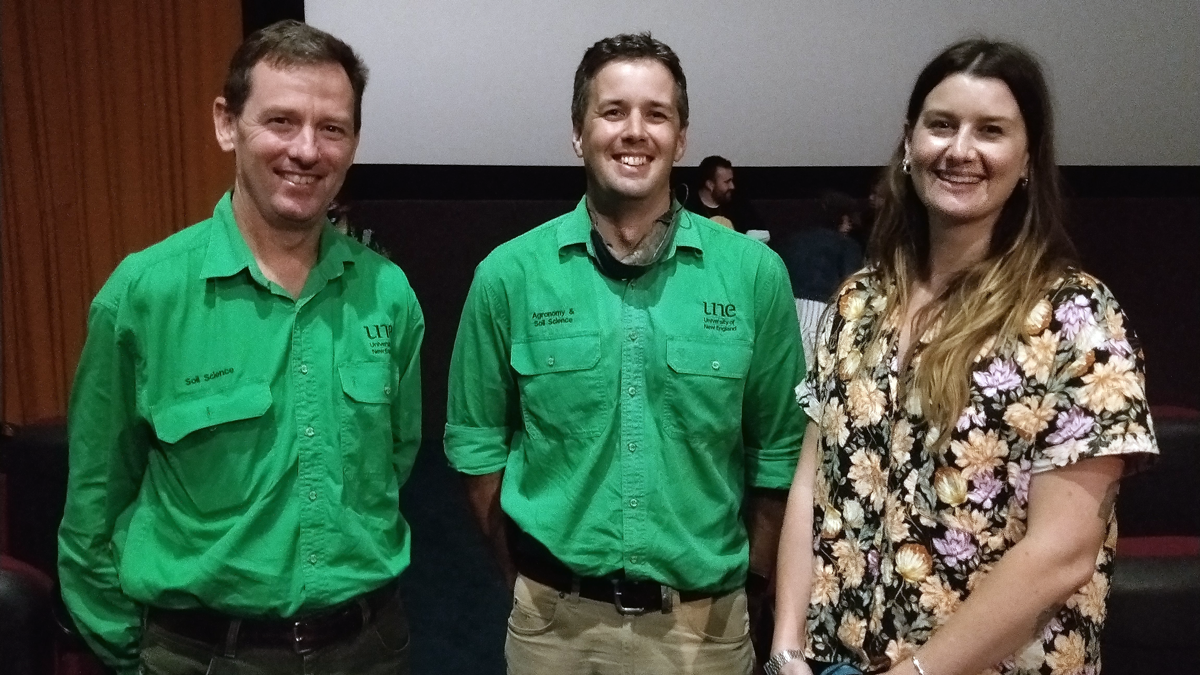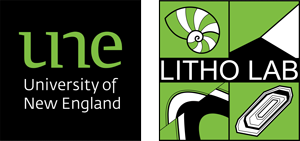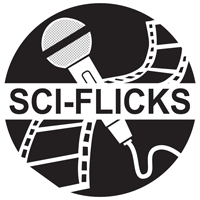Litho Lab (LLUNE) at the University of New England, Armidale, Anaiwan Country
Twitter: @200micron
Instagram: 200micron
Podcast: https://open.spotify.com/show/15mKQuJULm9TkHA4LAj2Tc
Website: https://www.marissajbetts.com/


I’m a geologist and palaeontologist at the University of New England (UNE) in Armidale, on stunning Anaiwan Country in New South Wales. I’m a Lecturer in Earth Science here at UNE and a founding member of the Earth Science research and teaching community we call 'LLUNE': short for Litho Lab, UNE. I prefer to say ‘community’ rather than just ‘group’ because that is what we are – a tight-knit community of researchers, teachers and students with diverse interests and expertise, but a shared passion for understanding how our Earth works, or has worked in the deep past.
In the last year or so, I’ve been part of the Superstars of STEM program (run by Science and Technology Australia), a two-year professional development program that equips women working in STEM with high-level communication skills and increases their visibility as experts. I can’t say enough good things about this program, but one thing it has done for me is give me confidence to take some risks and try new things. In academia we know that it is ‘publish or perish’, and so outreach and science communication to the public tends to get put on the back burner. When it came to outreach I would think of the usual things, and rarely had a lot of time for it (like most ECRs). But Superstars helped me think outside the box and gave me the push I needed to start the Sci-Flicks events last year.

The University of New England is a big part of a small town. Like all small towns, everyone is connected to everyone else in some way or another. This means that when you start talking about an idea, you naturally end up corralling all sorts of folks who might be able to help, or better yet, are keen to get involved. So, very quickly Sci-Flicks became an outreach collaboration between UNE Life (the body responsible for student and staff experience), the Belgrave Cinema and TuneFM (our university radio station). The idea is very simple: to use a film as a vehicle for science education to the public. People love going to the movies, and Sci-Flicks value adds to that experience with a short talk from a researcher before the screening and an audience Q+A afterwards. Blockbuster movies can often ‘stretch a friendship’when it comes to the science they reference. Sci-Flicks gives people the opportunity to have their questions myth-busted by a real scientist. They are fun events that connect the university with the broader community and showcase the awesome work of UNE researchers.
I pair these events with a half-hour interview with the speaker on TuneFM prior the screening. This content is used to advertise the events, and is recorded and kept as a podcast on Spotify. This is important, as the events themselves aren’t recorded, and for the speakers it is really valuable to be able to share the recording within their networks to promote themselves. Again, Superstars is to thank here – I’d never have thought of myself as a podcast or radio host, but I thought why not try! At the beginning I certainly had some self-doubt, but my speakers have all been so fantastic that our conversations just fly by. I love hearing their expert takes on the science in the films.
Even with COVID disruptions last year, the Sci-Flicks events have been really popular. The first film we screened was Jurassic Park (the 1993 original, of course). Here in our Earth Science discipline at UNE we have the Palaeoscience Research Centre, Australia’s largest and most diverse palaeo-centric research group, so I paired Jurassic Park with a talk and Q+A from one of our dinosaur palaeontologists, Dr Phil Bell, and it was huge. About 120 tickets were sold for that event alone. Since then, we’ve screened Gattaca with a talk from geneticist Dr Mary McMillan, The Meg with vertebrate palaeontologist Dr Nic Campione, The Martian with soil scientists Associate Professor Chris Guppy and Dr Richard Flave, and San Andreas with geologists Dr Luke Milan and Dr Tim Chapman. The San Andreas event, a film that came out in 2015, sold more tickets than Avengers: End Game that was premiering on the same night. Finding Nemo with marine biologist Dr Chris Goatley is coming up next, followed by Close Encounters of the Third Kind with physicist Dr Stephen Bosi and Robocop with computer scientist Dr Eddie Sadgrove.
To run Sci-Flicks, I do quite a bit of emailing to organise films and speakers, and I do a bit of preparation for the TuneFM interviews, and of course I have to go to the cinema and eat a choc top – I mean, see a movie – once a month (what a tough life) where I also MC the events, introduce the speakers and run the Q+A. One thing I’ve learned is that arranging films for public screenings is a bit more complicated than you might imagine. The cinema doesn’t have the rights to screen every film I ask for, so it can be a bit of a lucky dip. I’m really happy the Belgrave Cinema are keen on the Sci-Flicks events, because they are the ones who have to liaise with their distributor to see if we can secure the films I ask for. There is also a team of people at UNE who have jumped on board and are absolute legends for promoting the events on TuneFM and social media. Sci-Flicks has worked out to be pretty good value, I think: for relatively minimal outlay we get ticket sales, promotion of researchers, their labs and the university, some top-notch sci-comm (including a podcast) and a movie. Not a bad deal.
Our UNE student-run Geoscience Society have adopted regular film nights too. These are smaller get-togethers on campus and my main role is basically just booking the lecture theatre! I’m more than happy to facilitate these events for our students who have been isolated for several years because of COVID. Small events on campus provide great opportunities to screen some very niche geo and palaeo-related films. One of the first we did was a film called Ice Crawlers, about giant killer trilobites on the loose in Antarctica. I’m not even sure this was in the ‘so bad it’s good’ category, but it was a hit with staff and students alike. Other hilariously bad geoscience films we’ve tackled are The Core (burrowing down the centre of the Earth is possible thanks to an amazing new element, 'Unobtanium') and Dante’s Peak (Pierce Brosnan driving on actual lava anyone?). But these nights are also opportunities to watch fantastic documentaries (such as Into the Inferno) or other films that make you feel excited about geoscience.
The science outreach I do serves several purposes: education to the public, advertising myself and my research, and community-building. Diversity in STEM is poor, but it tends to be worse in the geosciences. A strong sense of community helps to make people from minorities and diverse backgrounds feel welcome, and goes a long way to helping improve diversity in STEM fields. Events like Sci-Flicks and smaller, student-run film nights might seem like just a bit of fun, but are essential opportunities to build relationships and a sense of community. Undergraduate students don’t tend to know how important 'networking' is yet, but it often happens informally, and giving students the shared experience of a terrible B-grade movie is very bonding!
I’ve been thinking recently about why I’ve gravitated to film as a science outreach medium. Firstly, it is probably because it’s easy to piggyback on people’s love of watching films and going to the movies. The film acts a bit like the spoonful of sugar to help the science medicine go down. But there is something more important I think. What films tend to do really effectively (much better than most scientists) is leverage people’s emotions. As scientists, we are trained to communicate effectively with other scientists, and emotion is kept well out of it. So, in communicating to the lay person, many scientists try so hard to make sure their facts can be easily understood that they forget to make a genuine connection with their audience. Films can give people feelings about something that motivates them much more powerfully than facts. How many palaeontologists are there who decided they loved dinosaurs after watching Jurassic Park when they were kids? (Spoiler alert: it’s a lot, trust me). Yes, facts are key – this is the guts of sci-comm after all, and why I have real scientists talking at the Sci-Flicks events. But we must remember the human connection, as this is what ensures our facts can ‘land’ and have the most impact.
If you can get your local cinema to let you do something similar I would say go for it. I think it’s a win-win for all involved really. As an EMCR, you are probably time poor and I feel you. This was definitely something I thought about at the beginning, and I didn’t want to create a huge monster and then feel constant pressure to keep it alive. But to tell you the truth Sci-Flicks has been pretty good bang for my buck. After all, I’m just the MC! It’s my speakers that have to do the talks and answer all the tricky questions from the audience. I’m thinking of getting someone else on board to help me wrangle speakers and films, that would make it even easier. Mostly it’s just really fun, which is the whole point, right? I love seeing my students cack themselves at a terrible rubber trilobite puppet or be part of the audience at the cinema wondering if Mark Watney’s Martian potatoes are going to survive. I’ve still got lots more films on my list too, and there are so many great researchers at UNE I want to hear from.
I’ll be through all those choc top flavours in no time.
© 2025 Australian Academy of Science